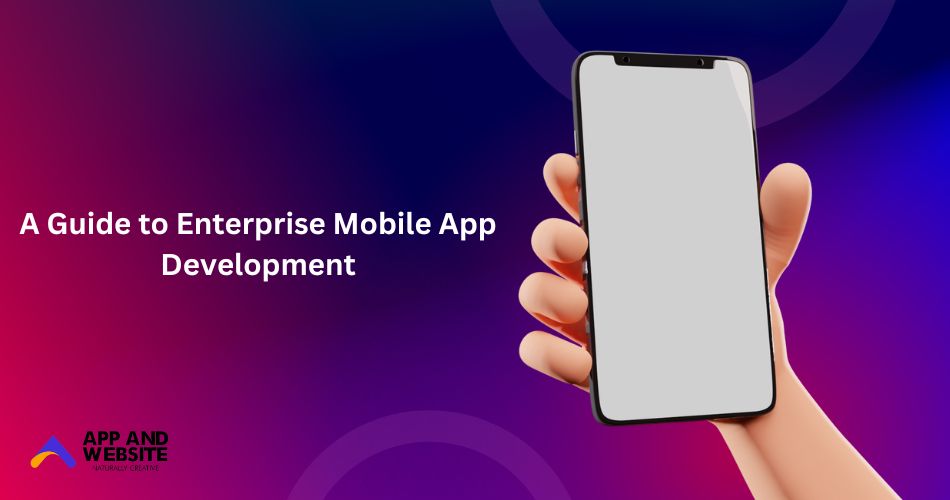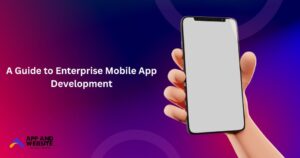Enterprise Mobile Apps is rapidly growing because its helping companies make better business strategies. According to 67% of businesses, enterprise mobility is becoming more crucial as it helps with data collection, sales support, customer engagement etc. This blog post will define enterprise app development, dive into classic and contemporary ways to app development and the benefits enterprise mobile applications can bring to your business.
Additionally, we’ll explore the several kinds of enterprise mobile apps that you may create to handle business activities and improve overall organizational productivity, including CRM, ERP, and HRM apps.
This blog article will provide information and understanding for developing enterprise mobile apps, regardless of your background in development or IT. Now let’s explore the realm of enterprise mobile apps and see how they might improve operations and increase growth for your company.
What is Enterprise Mobile App Development?
Enterprise mobile app development is the process of developing applications for mobile devices to create custom-made solutions to improve businesses. The goal of this application is to streamline processes, optimize business performance and increase efficiency for the employee by providing them with the appropriate tools in the current competitive business world.
This application is designed to link the existing business processes and handle functions such as financial management, customer relationship, the content management for the different sectors of the business. It will manage all this information in addition to providing a security system for the organization and employing a mobile application to drive better user experience for the business. The objective when creating this app is to prioritize scalability, speed and ensuring the software is tailored to the company’s needs.
Traditional vs Modern Enterprise App Development
Businesses have the choice between traditional and modern approaches to meet their requirements. Traditional enterprise app development involves custom coding using complex languages to meet the requirements of the client. On the other hand, modern development techniques use cloud-based systems to increase scalability and security. Let’s have an in-depth look at both traditional and modern app development.
1. Traditional
Traditional enterprise app development customarily involves a more extended development cycle. This is because applications are custom-created utilizing intricate programming languages and frameworks. They are constructed to satisfy specific business necessities; however, these apps frequently lack adaptability, posing a challenge in modifying them in response to evolving business demands. Additionally, scalability becomes complicated as there is a certain amount of dependency between the operating system and the application.
Furthermore, traditional development can require a high level of customization if new updates are needed in the system which also makes this type of application costly. Finally, the security aspect also poses some challenges increasing the risk of data breaches and cyber-attacks.
2. Modern
Agile methodologies highlighting iterative development and collaboration, are often incorporated in modern development. Modern app development simplifies the adjustment process for businesses as market trends or customer demands evolve. There are also dependencies between the operating systems and applications increasing the scalability.
Modern app development utilizes cloud-based systems which offer scalable infrastructures and reduce the need for business to manage their servers. This method accelerates development and deployment processes and simplifies upgrades and maintenance at the same time. Furthermore, modern enterprise app development is more cost-effective, and businesses can avoid the expense of constructing and maintaining custom infrastructure. Finally, this type of application development has a great data security system to protect internal and customer data.
7 Types of Enterprise Mobile Apps You Can Develop
There are various specialized enterprise applications to enhance an organization’s operations based on their requirements. Let’s have a closer look into some specific enterprise mobile applications and their functions in driving efficiency productivity and strategic insights for businesses.
1. Customer Relationship Management (CRM) Apps
CRM applications assist businesses in tracking sales activity, managing client relationships, and improving customer satisfaction. CRM apps help with sales forecasting, customer management and streamline sales processes by tracking leads and managing customer data.
2. Enterprise Resource Planning (ERP) Apps
ERP mobile apps increases organizational efficiency by combining key company functions into a single system, such as supply chain, finance, and HR. Development of these mobile applications offer a single platform that streamlines departmental decision-making and information exchange.
3. Human Resource Management (HRM) Apps
Payroll, benefits administration, performance reviews, and recruiting are all made easier with the use of HRM apps. In addition to ensuring compliance with regulations, building a human resource application can automate HR operations and improve worker satisfaction.
4. Supply Chain Management (SCM) Apps
Development of applications to help regulate the flow of products and services can improve efficiency and minimize expenses. SCM apps optimize the supply chain by providing tools for order processing, managing inventory, and logistics.
5. Project Management Apps
Building applications to facilitate efficient project planning, execution, and tracking for teams can enhance productivity and improve overall collaboration among team members. Project management apps tools help teams work together more effectively by helping them keep track of assignments, deadlines, and resources.
6. Business Intelligence (BI) and Analytics Apps:
Developing an application that shows analytics and forecasts of the business and provides insights into the key performance indicators can really help a company see the market trends. Business intelligence apps provide tools for analysis, visualizations, and a forecasting system to assist businesses in making well-informed decisions.
7. Financial Management Apps:
Financial Management Apps provide financial management accounting, budgeting, and financial interactions, ensuring accuracy and compliance. Development of financial applications further assists companies with forecasting, financial report generation, and expense management.
How To Develop Enterprise Applications: 7 Steps to Follow
The process of enterprise application development is structured aiming to create effective solutions that meet the specific needs of the business. This section outlines the key steps involved in the development process ensuring that when building an app for an enterprise, the application not only meets current business needs but also is scalable to adapt to future advancements.
1. Planning and Requirements Gathering
The initial stage in developing an effective business application consists of doing an analysis of the requirements and objectives of the client. Their discussions center on the intended utility of the application. The following are common questions for research and reflection: What are the problems needing resolution? Who is part of our user base? What procedures are indispensable for the solution? This period of reflection and research is important as it ensures the application aligns with expectations and goals.
2. Choose Tech Stack for App Development
Selecting the right technology stack is essential when creating a business application. This selection has an impact on maintainability, security, and other aspects of the application in addition to performance and scalability. Considering programming languages or deciding between traditional and microservices is as important as selecting the appropriate frameworks to match the goals of the project as every element must be carefully considered. This is to satisfy the requirements of the application and plan for its future growth.
3. Architecture Design
Following the collection of requirements, the team needs to construct the enterprise application’s architecture. This involves creating the system architecture for the database and integrating points with other systems. Scalability and flexibility are ensured and the framework for effective development is established during the architecture and design phase.
4. Database Design
A well-crafted database forms the base of any high-functioning application. In order to support the functionality of the application, database design involves structuring the data items and defining the linkages between them. All this intends to uphold the effectiveness of the application. Strong database design guarantees quick and effortless data management. It enables swift retrieval and storage of data in addition to the design satisfying the performance needs. It effortlessly supports future alterations and scalability with ease.
5. Prototyping (Show UI/UX) of App
Prototyping is an important step as it creates the vision for how the final application function and visualization will be. In this stage, ideas are transformed into models so that stakeholders can interact and try using the model of the application. This stage creates an opportunity to improve and refine the user interface and experience based on the feedback of the stakeholders and helps create a more effective and user-friendly application.
6. Development Phase of App
Coding, component integration, and application building are all done by the development team during this stage. Certain tasks that take place in this stage ensure that the application’s quality and functionality requirements are adhering to best practices, making use of the proper frameworks and libraries, and carrying out exhaustive testing.
7. Testing and Quality Assurance
Quality assurance and testing are vital to the development process as they are designed to guarantee the app’s performance and reliability. This stage incorporates various tests like functional testing, performance testing, and security testing. Comprehensive quality assurance tests verify that the program complies with regulations and operates as intended in various settings.
8. Deployment and Maintenance
Deployment of an application in a production environment and the availability to users marks the start of its life. However, this is not the end of the process. Maintenance is an ongoing effort that involves regular updates, performance monitoring, and problem-solving to ensure that the software meets all user demands and is functioning in an optimal way. As new needs and technologies are introduced, this final step keeps the application up-to-date and running at optimal efficiency.
What Are the Business Benefits of Developing Enterprise Apps
Enterprise apps are essential for improving a company’s numerous aspects. Through the creation of personalized mobile applications, companies may benefit from several advantages that enhance their effectiveness, output, and financial success. Here’s a closer look at some of the main advantages creating enterprise apps has for businesses.
1. Enhanced Efficiency
Enterprise software automates business operations, whereby workflows are simplified, and redundant work is eliminated. The application automates the different business processes which gives the employees the necessary tools to work accordingly and increase productivity.
2. Improved Communication and Collaboration
Efficient communication is the key element of the business organization. Through enterprise applications, employees can maintain better communication and collaborate more effectively through shared access to tools and documents in the centralized system.
3. Better Decision-Making
Most enterprise apps consist of functionalities such as data analytics and reporting, thus providing users with real-time business evaluations. Enterprise mobile application gives access to up-to-date analytics of the business which helps managers notice market trends and make better decisions.
4. Increased Customer Satisfaction
The customer-facing enterprise apps functions, such as CRM apps or service portals, provide the users with access to information, support, and services. The application enables better interaction with customers which improves customer loyalty and satisfaction.
5. Enhanced Security and Compliance
Enterprise apps can be modeled so they have strict safety protocols and allow data confidentiality following the specific regulations in the industry. The businesses can filter & authenticate data due to the centralized data encryption, authentication, and access controls mechanism.
Features to Incorporate While developing Enterprise Applications
Building enterprise applications with robust and dynamic features is important. Enterprise applications are developed to meet certain business requirements ensuring efficiency, scalability, and security. Here are some of the critical features to consider in the process of developing enterprise applications.
1. User Authentication and Authorization
It is necessary to have controls in place to ensure that access to enterprise applications is secured. Robust user authentication and authorization processes prevent their identity from being duplicated and keep the confidential information safe from their hands.
2. Data Security and Encryption
Enterprise Application consists of internal data from both the organization and the customer. The system’s security is dependent on the usage of techniques like user authentication, encryption, and access control to protect against cyber attacks, illegal access, and data leaks.
3. Integration Capabilities
Integration with APIs, databases, and other apps is a common requirement for enterprise applications. Process automation, enhanced workflow between systems, and smooth data sharing are all made possible by integration capabilities.
4. Workflow Automation
Automation can be carefully chosen and incorporated into the program to improve efficiency and reduce human error. The workforce will have more time to focus on essential duties requiring human involvement.
5. Customization and Configurability
Creating options for the business users to customize the application enhances their satisfaction and performance. The design of the application allows for the business user to have a product that matches their preferences making it a more personalized product.
6. Audit Trail and Logging
Monitoring the actions that users take is essential. The implementation of an audit trail and logging function captures all user actions on the program, allowing for responsibility in the event of fraudulent behavior.
7. Reporting and Analytics
Report generating and showcasing analytics is a key feature of the application as it will show different trends and performance indicators to make better forecasts for the business.
8. Mobile Accessibility
Enterprise mobile apps are available on smartphones and tablets due to the growing popularity of mobile devices. Users may access important company information and complete activities in real time.
9. Reliability and High Availability
Enterprise applications are always accessible to the appropriate individuals, and because of their high availability, users rarely encounter any downtime.
10. Collaboration Tools
Enterprise applications come with collaborative tools to facilitate teamwork and communication. Tasks like document sharing, real-time conversation and collaboration, and shared workspaces have become easier.
11. User Training and Support
User guides and tutorials are a few examples of resources that can be used to help users learn how to utilize an application efficiently and troubleshoot any issues that could come up. User support is a key feature that will be incorporated within the application.
12. Security Patching and Updates
Keeping security measures up to date is crucial for data privacy and availability. Regular updates will allow the application to recognize trending threats.
7 Future Trends of Enterprise Application Development: Key Trends
Enterprise application development will continue to change and advance based on the market needs. Businesses have to adopt to innovative technologies and methodologies to be capable of competing in the market. This section delves into some of the trends that are shaping future application development focusing on scalability, efficiency, and intelligent solutions.
1. Microservices Architecture
This design and architecture is becoming more common because of its high scalability and advanced application. It involves splitting larger applications into more manageable, freely interconnected services that can be implemented and scaled. Microservices facilitate better maintenance, flexibility, and adaptability.
2. Cloud-Native Development
The goal of cloud native development is to create apps that are optimized for cloud settings. It enables smooth scalability, resilience, and quick deployment by utilizing cloud services, orchestration technologies like containerization.
3. Low-Code/No-Code Development
Platforms for low-code and no-code development are becoming increasingly common, enabling users to write applications with less code. These platforms make it easier to develop projects faster, collaborate more effectively, and be less dependent on conventional development cycles.
4. Integration of Artificial Intelligence (AI) and Machine Learning (ML)
Enterprise applications increasingly utilize AI and ML technology. They improve productivity and decision-making by enabling intelligent automation, forecasting, natural language processing, and improved analysis of data.
5. Progressive Web Apps (PWAs)
Progressive Web Apps are becoming popular as they provide intuitive interaction for users. They are developed using common languages like HTML, CSS and JavaScript but offer a wide variety of applications like push notifications and device hardware access.
6. Cross-Platform Development
Cross platform development uses a single codebase and allows to develop software applications that work across multiple operating systems. This methodology is efficient and has great scalability.
7. Generative AI Implementations
Generative AI is being integrated into enterprise systems and applications to generate code and innovative content and designs autonomously. Using generative AI, the development process becomes faster, and it creates a personalized user experience.
How Much Does It Cost to Create Enterprise Application?
Enterprise application development costs can differ significantly based on several variables, such as the application’s complexity, platform, features, and development team’s location. Other major factors affecting the cost include functionalities and features, data storage, quantity of workflows, compliance standards and integrations.
Simple small sized application: $10,000 to $50,000
- A simple application which basic functions can cost from $10,000 to $50,000.
Medium Sized: $60,000 to $12,000
- With more advanced and medium complexity app, it might cost around $60,000 to $120,000.
Advanced: >$150,000
- If the application uses the latest technology and AI, it might cost more than $150,000.
How Long Does It Take to Make Enterprise App?
There are a couple factors that influence the timeline to develop the enterprise application. Some factors that influence the timelines are the initial phase of collecting the data and requirements, feature and integration complexities, availability of the required requirements and then the final cycle of testing and modifying the application to meet the requirements.
Smaller Applications: 3-6 months
- For comparatively simple assignments with minimal user bases, integrations, and functionalities, the smaller applications can take from 3 to 6 months.
Medium Applications: 6-12 months
- With medium sized applications with more medium-advanced integrations and security systems, it might take from 6 to 12 months.
Advanced Applications: >12 months
- For very advanced enterprise applications with greater scalability and functionality, it could take over 12 months.
How can App and Website LLC help you in Enterprise Mobile App Development?
App and Website LLC differentiates itself as a leading app development company, offering enterprise app development services focused on meeting business needs. App and Website provides knowledgeable guidance throughout the development process. They collaborate closely with customers to comprehend their demands as a business, suggest the greatest features and technologies, and make sure the finished product meets the objectives of the customer. For companies that are unfamiliar with app development or have complicated needs, this advice is extremely helpful. To ensure that clients are informed and involved at every stage of the process, the organization places a high importance on collaboration, transparency, and clear communication. Because of this customer-centric approach, the final app is more likely to satisfy clients’ needs and add value to their businesses.
App and Website LLC is a trustworthy partner for companies looking for enterprise app development services. The company guarantees that every app is in line with its clients’ needs and adds value to their business through the provision of complete services, customized solutions, professional advice, and a customer-focused approach. App and Website LLC can assist you in achieving your objectives with superior mobile app development, whether you’re trying to increase customer service, communicate more effectively, or streamline processes.






